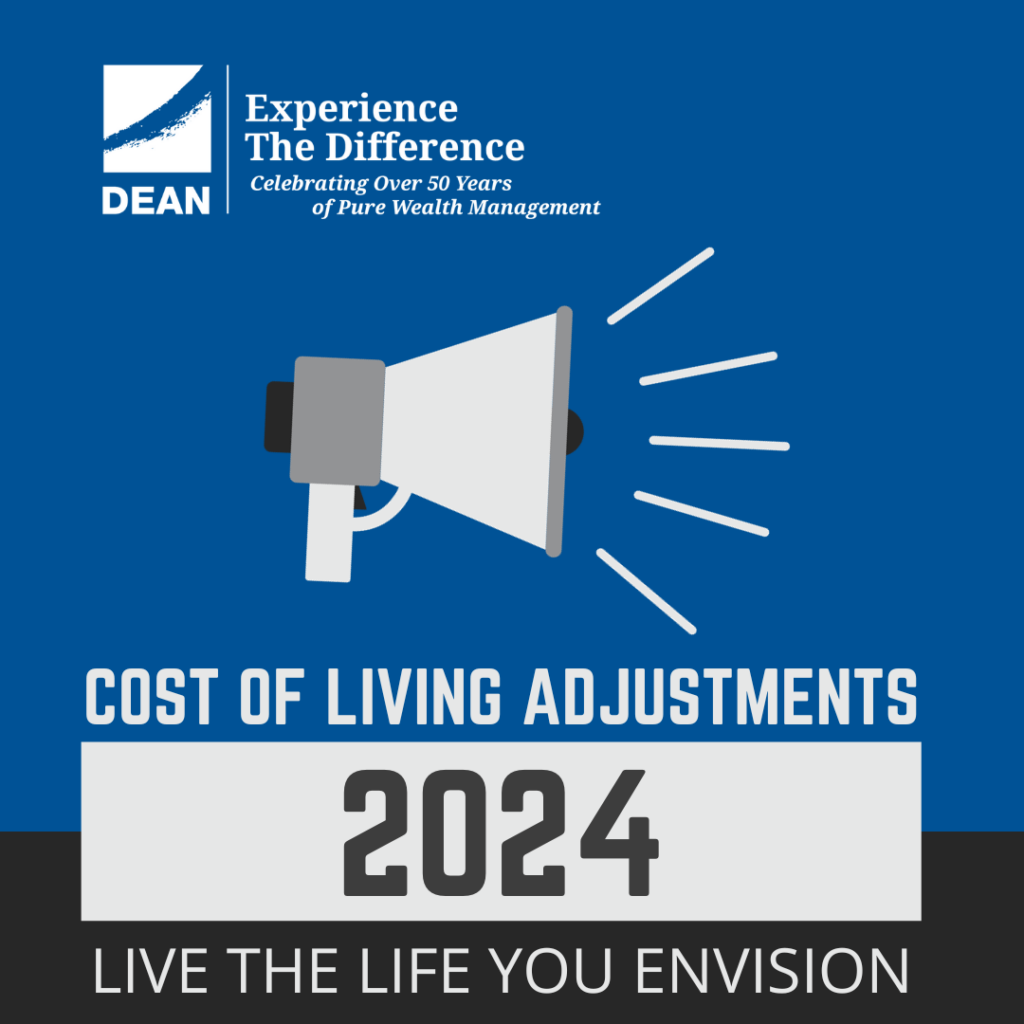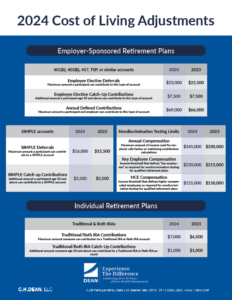
Each year the Internal Revenue Service (IRS) evaluates its limitations for employer-sponsored retirement plans (401(k), 403(b), 457, TSP, etc.), individual retirement accounts (IRA), Flexible Spending Accounts (FSA), Health Savings Accounts (HSA), dependent care accounts, and payroll taxes for Social Security, Medicare, and Unemployment. Many of these limits are adjusted annually to reflect inflation or the increase in the cost of living. Click here to download a free PDF chart that highlights the IRS limits for 2024 that may apply to you as an employee or business owner.
Employer‐Sponsored Retirement Plans
Defined Contribution Plans
A defined contribution plan is a retirement plan in which a certain or ‘defined’ amount of money is set aside or ‘contributed’ by an employee or employer. An employee who contributes to the plan is considered a participant. These plans usually allow participants to choose investment options that will hopefully grow over time to provide money during retirement.
Defined contribution plans are known as 401(k), 403(b), 457, or TSP plans.
• 401(k) plans are generally offered by private, for‐profit companies.
• 403(b) plans are available to employees of certain public schools and tax‐exempt organizations.
• 457 plans are commonly available to state and local government employees and contractors.
• TSPs are available to federal government employees.
In 2024, the amount of money that can be set aside by the employee (participant) for the year is $23,000, up from $22,500 in 2023. Employee contributions can also be known as elective deferrals. This is the maximum amount that participants under 50 years old can contribute to one of the employer-sponsored retirement accounts.
If an employee will be 50 years old in 2024, they can set aside an additional $7,500, unchanged from 2023. This additional contribution is called an employee elective catch-up contribution.
For 2024, the maximum combined amount that the employee and employer can contribute is $69,000. This limit is referred to as the Annual Defined Contribution limit.
There are other types of employer‐sponsored retirement plans that may be available to you, including Simplified Employee Pension (SEP) and Savings Incentive Match Plan for Employees (SIMPLE) IRAs.
Simplified Employee Pension (SEP)
All contributions to SEP IRAs are funded by your employer. The limit is 25% of your compensation up to the annual defined contribution limit ($69,000 for 2024). Self-employed business owners can contribute 20% of their net adjusted self-employment yearly income up to the annual defined contribution limit ($69,000 for 2024). We recommend self-employed business owners consult with their tax preparer to calculate their net adjusted self-employment annual income accurately.
Savings Incentive Match Plan for Employees (SIMPLE)
A SIMPLE is a defined contribution retirement plan that can be used by a small business (less than 100 employees). Small businesses can set up a SIMPLE IRA or 401(k).
In 2024, the amount of money that can be set aside in a SIMPLE IRA or SIMPLE 401(k) by the employee (participant) for the year is $16,000, up from $15,500 in 2023.
If an employee will be 50 years old in 2024, they can set aside an additional $3,500 in their SIMPLE.
In a SIMPLE IRA or SIMPLE 401(k) plan, the employer can contribute money to the plan in two ways. The employer can give every employee 2% of their respective compensation. Alternatively, the employer can match employee contributions up to 3% of the employee’s compensation.
There are differences between a SIMPLE IRA and SIMPLE 401(k) with regard to the maximum contributions allowed by the employer. For 2024, the maximum combined amount that the employee and employer can contribute to a SIMPLE IRA is $32,000.
EXAMPLE
ABC Medical Group has established a SIMPLE IRA for its employees and has elected to make the 3% matching contribution to the plan for the 2024 plan year. Jane, an employee, is 35 years old and makes $550,000. Jane has decided to contribute the maximum allowed amount of $16,000. ABC Medical Group can contribute 3% of $533,333 or $16,000. This allows for a combined total of $32,000 from both Jane and ABC Medical Group.
Alternatively, for 2024, the maximum combined amount that the employee and employer can contribute to a SIMPLE 401(k) is $26,350.
EXAMPLE
ABC Medical Group has established a SIMPLE 401(k) for its employees and has elected to make the 3% matching contribution to the plan for the 2024 plan year. Jane, an employee, is 35 years old and makes $550,000. Jane has decided to contribute the maximum allowed amount of $16,000. ABC Medical Group can contribute 3% of $345,000 (Annual Compensation limit set by IRS) or $10,350. This allows for a combined total of $26,350 from both Jane and ABC Medical Group.
The contribution limits listed above are also subject to income limitations. One such limit is 100% of compensation, meaning you cannot contribute more than you earned for the year to your employer-sponsored retirement account.
Your employer is also limited in what they can contribute to your account by the annual employee compensation limit (referenced in the above example). This is the maximum amount of income that can be used in calculating an employer contribution (non‐elective safe harbor or matching contributions). For 2024, the compensation limit is $345,000, up from $330,000 in 2023.
EXAMPLE
John will make $500,000 in 2024, and his employer, DEF LLP, will contribute 3% of the compensation. DEF LLP would be allowed to contribute $10,350 ($345,000 x 3.0%), because the annual employee compensation limit restricts them.
To ensure retirement plans benefit all employees equally, they undergo discrimination testing. As a result of this testing requirement, employers are limited by thresholds on key employees and highly compensated employees’ compensation. For 2024, the key employee threshold is $220,000, and the highly compensated employee threshold is $155,000 (or a 5% or greater interest in the company regardless of income).
Defined Benefit Plans
Defined benefit plans are also known as pension plans. A pension plan will pay an employee a calculated amount based on the length of service and/or the salary they earned at the time of retirement. These plans rely on the company to set aside money and pick investments that will provide the “defined benefit” for the employee during retirement.
For 2024, the annual benefit for a participant in a defined benefit plan is limited to $275,000, up from $265,000 in 2023.
Individual Retirement Plans
An individual retirement account (IRA) is an account that an individual can establish without an employer. An individual can establish a Traditional IRA account or a Roth IRA account. A Traditional IRA account generally allows an individual to avoid paying tax on the dollars contributed to the account in the year they deposit the funds. A Roth IRA account generally allows an individual to avoid paying tax on the dollars withdrawn from the account in the year they withdraw the funds.
The IRS limits the amount an individual can contribute to these types of accounts. In 2024, the Traditional IRA and Roth IRA contribution limits are $7,000, up from $6,500 in 2023. If you are 50 or above, you can make an additional catch‐up contribution of $1,000. Additionally, Roth IRA contributions may be limited if your income is $230,000 or higher for married filing jointly taxpayers or $146,000 or higher for single taxpayers.
Non‐Retirement Savings Accounts
Flexible Spending Accounts
Flexible Spending Accounts (FSAs) allow you to save money tax‐free to pay qualified health care
expenses. The 2024 FSA contribution limit is $3,200 per employer, up from $3,050 in 2023. Funds can be used for certain medical and dental expenses, such as deductibles, copayments, prescriptions, medical equipment, and other supplies. In general, funds in your FSA must be used within the plan year but may be subject to a grace period or carry-over, depending on the options offered by your employer.
Health Savings Accounts
Health Savings Accounts (HSAs) are tax‐advantaged accounts that allow you to save for future qualified medical expenses, similar to FSAs. Unlike FSAs, you are not required to use your HSA contributions in the year you contribute them. The 2024 HSA contribution limit is $4,150 for an individual or $8,300 for a family, up from $3,850 and $7,750, respectively, in 2023. If you are age 55 or older, you are eligible to make a catch‐up contribution of $1,000 (no change from 2023).
To qualify for an HSA, you must be covered by a high‐deductible health plan (HDHP). For 2024, an HDHP must have an annual deductible of greater than $1,600 for an individual or $3,200 for a family ($1,500 / $3,000 in 2023). It must also have an out-of-pocket maximum of $8,050 or less for an individual or $16,100 or less for a family in 2024 ($7,500 or $15,000 in 2023).
Dependent Care Accounts
Dependent care accounts are a tax-free way to save money for qualified dependent care services, such as preschool, summer camp, daycare, or before or after school programs. Similar to FSAs, unused funds are forfeited at the end of your plan year. The 2024 contribution limit is $5,000 for single or married filing jointly taxpayers and $2,500 for married filing separately taxpayers, unchanged from 2023.
Payroll Taxes
Social Security
In order to fund Social Security, employees and employers pay a tax on wages up to a current level which is called the Social Security wage base. The social security wage base increased to $168,600 for 2024, up from $160,200 in 2023. The Social Security tax rate remained the same from 2023 to 2024 at 12.4%, half of which (6.2%) is paid by the employee, with the other half paid by the employer.
Medicare
In order to fund Medicare’s Hospital Insurance program, employees and employers pay a tax on wages. There is no limit on the income subject to Medicare taxes. The Medicare tax rate remained the same from 2023 to 2024 at 2.9%, half of which (1.45%) is paid by the employee, with the other half paid by the employer.
The Affordable Care Act (ACA) added an extra Medicare tax for high earners, known as the Additional Medicare Tax. An individual with more than $200,000 (married filing joint $250,000) has to pay an additional 0.9% in Medicare taxes. This Additional Medicare Tax is the sole responsibility of the employee. It is not split with the employer.
Federal Unemployment Tax Act
The Federal Unemployment Tax Act provides payments of unemployment compensation to workers who have lost their jobs. The Federal Unemployment Tax Act rate remained the same from 2023 to 2024 at 6.0%, all of which is paid by the employer. Employers pay this tax on the first $7,000 of employee earnings and may be eligible to receive a credit of up to 5.4% for any state unemployment taxes they pay.
